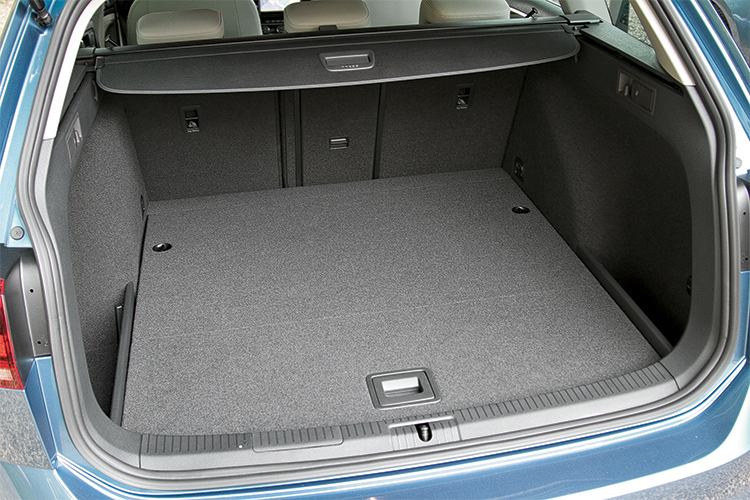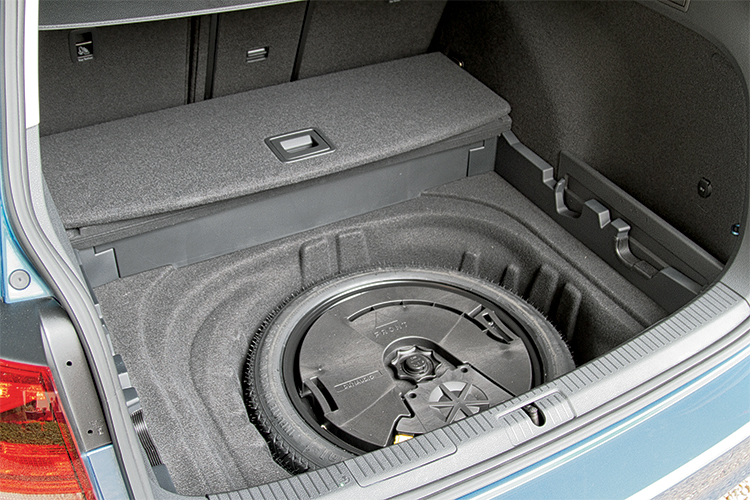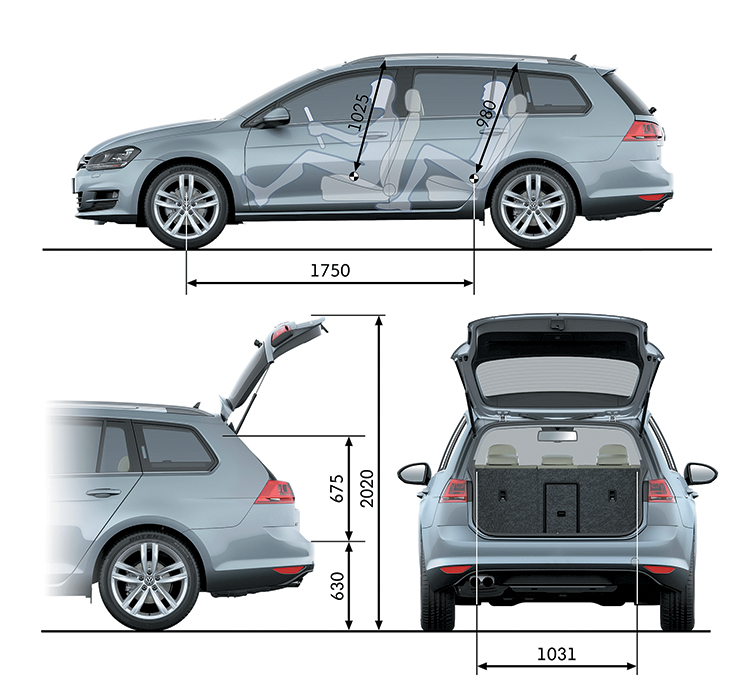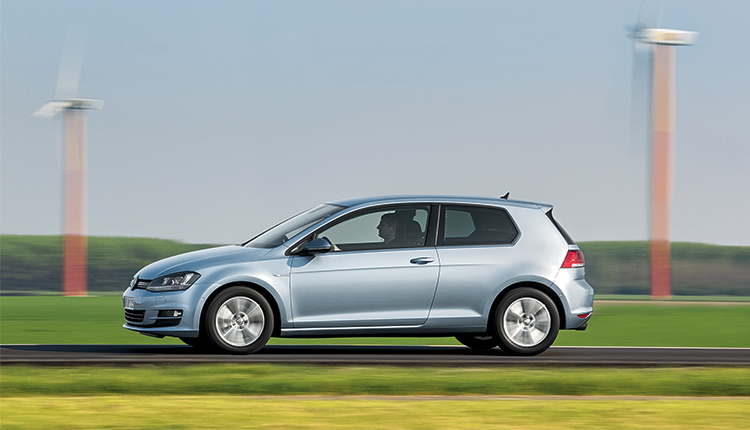The new Volkswagen Golf Variant is a layout masterpiece. It is only 28 mm longer than the previous one, and the trunk immediately added one hundred liters - up to 605 liters! And the Variant rides... In Amsterdam, I had the opportunity to evaluate all the most popular options - with 1.4 TSI engines with a capacity of 122 and 140 hp, as well as with a 2.0 TDI turbodiesel (150 hp, 320 Nm).
Huge luggage compartment! If you fold the rear sofa, then the amount of usable space is 1620 liters versus 1495 liters for the previous station wagon. By the way, the Golf hatchback has a trunk volume of 380-1270 liters. As for the Option, only the platform Skoda Octavia Combi (610-1740 l) is more practical in the class, but it is almost ten centimeters longer.
I first got a Golf Variant 2.0 TDI with a manual transmission - the most sought-after modification in Europe. Quiet, peppy, economical and very high-torque diesel - peak 320 Nm is available from 1750 to 3000 rpm. He is not afraid of high speeds either - the red zone begins only after 5000 rpm. The diesel station wagon is 82 kg heavier than the hatchback, and therefore 0.3 s slower in acceleration from standstill to 100 km / h. However, I am ready to believe in the declared 8.9 s! In fourth gear, you can drive like an “automatic”, accelerating from 50 to 150 km / h. And now it is much more convenient to use the clutch - the electronics automatically raises the engine speed as soon as it feels the closing of the discs.
The interior is like a hatchback. In advanced trim levels (Comfortline and Highline), even more comfortable ErgoActive chairs are available with adjustments in 14 directions, including with a cushion extension
The smoothness of the ride exceeded all expectations, especially in the Comfort mode of the DCC (Adaptive Chassis Control) active suspension - no worse than decent business sedans! Alas, neither diesel nor electronically controlled shock absorbers are provided for Russia - as in the case of a hatchback, station wagons will be brought to us with a suspension for bad roads: with stiffer springs and ground clearance increased by a centimeter. And if we take into account that the carrying capacity of the station wagon per centner is higher than that of the hatchback (600-611 kg, depending on the modification), its smoothness will obviously be worse.
But the handling has not changed! That amazing "feeling of the steering wheel" that is inherent in the new Golf has been preserved. Of course, for active drivers, petrol cars with a lighter 1.4 TSI turbo engine are preferable. With it, the Golf behaves more “neutrally” in corners, while the diesel station wagon more actively went out of the turn.


Options for automatically opening the trunk with a “kick” or button have not yet been offered. But the tailgate rises 10 cm higher than before - by 2020 mm. Instead of a dokatka, we will have a full-size spare tire in the underground. In the same place, in addition to the tool, there are holders for the removed curtains and crossbars.

You pull the hidden handle, the green light comes on - and the hitch pops out from under the bumper!
0 / 0
First I tried the base Variant 1.4 TSI (122 hp, 200 Nm), and then switched to the boosted version (140 hp, 250 Nm) and… didn't notice much difference! Yes, almost a second of difference in a jerk from standstill to a hundred (9.7 vs. 8.9 s) is felt, but in both cases, enviable traction in the widest rev range captivates. Moreover, for a weaker unit, peak 200 Nm “spread” from 1500 to 4000 rpm, and for a more powerful motor, a “shelf” of 250 Nm is 500 rpm shorter. The average fuel consumption in a comparable driving mode differed by only 0.2 liters and did not exceed 7.0 l/100 km. Economic wagon!
But how expensive it is, it's hard to say. In Russia, Volkswagen Golf Variant will appear only next year. Prices, engines and configurations will be announced closer to the start of sales. For example, in Germany, the base station wagon costs from 18,950 euros, or 1,775 euros more than a three-door hatchback. It turns out that for every additional liter of usable space, the German pays five euros.

The widest opening and low threshold make it easy to load a bulky refrigerator or pieces of furniture. The maximum volume of the compartment reaches 1620 l (+125 l compared to its predecessor)
| Passport data | ||||
|---|---|---|---|---|
| Automobile | Volkswagen Golf | |||
| Modification | 1.4 TSI (122 hp) | 1.4 TSI (140 hp) | 2.0 TDI | |
| body type | 5-door station wagon | 5-door station wagon | 5-door station wagon | |
| Number of places | 5 | 5 | 5 | |
| Trunk volume, l | 605-1620* | 605-1620* | 605-1620* | |
| Curb weight, kg | 1329 (1350)** | 1329 (1350)** | 1329 (1350)** | |
| Gross weight, kg | 1860 (1880) | 1860 (1880) | 1860 (1880) | |
| Engine | gasoline, with direct fuel injection and turbocharging | diesel, turbocharged | ||
| Location | front, transverse | front, transverse | front, transverse | |
| Number and arrangement of cylinders | 4, in a row | 4, in a row | 4, in a row | |
| Working volume, cm3 | 16 | 16 | 16 | |
| Cylinder diameter / piston stroke, mm | 1395 | 1395 | 1968 | |
| Compression ratio | 74,5/80,0 | 74,5/80,0 | 81,0/95,5 | |
| Number of valves | 10,0:1 | 10,0:1 | 16,2:1 | |
| Max. power, hp/kW/r/min | 122/90/5000 | 140/103/4500-6000 | 150/110/3500-4000 | |
| Max. torque, Nm/r/min | 200/1500-4000 | 250/1500-3500 | 320/1750-3000 | |
| Transmission | 6-speed, manual (7-speed, robotic) | 6-speed, manual (6-speed, robotic) | ||
| Drive unit | front | front | front | |
| Front suspension | independent, spring, McPherson | independent, spring, McPherson | ||
| Rear suspension | independent, spring, multi-link | independent, spring, multi-link | ||
| Front brakes | disc, ventilated | disc, ventilated | disc, ventilated | |
| Rear brakes | disk | disk | disk | |
| Tires | 205/55R16 | 205/55R16 | 205/55R16 | |
| Maximum speed, km/h | 204 (204) | 213 (213) | 218 (216) | |
| Acceleration time 0-100 km/h, s | 9,7 (9,7) | 8,9 (8,9) | 8,9 (8,9) | |
| Fuel consumption, l/100 km | mixed cycle | 5,3 (5,1) | 5,3 (5,0) | 4,2 (4,5) |
| CO 2 emissions, g/km | 124 (118) | 121 (116) | 108 (119) | |
| Fuel | gasoline AI-95 | gasoline AI-95 | diesel fuel CN-51 | |
| * With rear seats folded down ** Data in brackets - for cars with a robotic gearbox |
||||

Theoretically, a Golf TDI BlueMotion with a 1.6 TDI engine (110 hp, 250 Nm) and a declared average fuel consumption of 3.2 l/100 km on a 50-liter tank can travel over 1,500 km, emitting only 85 g of CO2 per kilometer. Efficiency was achieved mainly due to the “stretched” range of the six-speed gearbox, other engine settings, energy recovery, Stop / Start system, tires with reduced rolling resistance and lightening by 49 kg (up to 1295 kg). I got an average of more than 4.0 l / 100 km - however, in the rain
